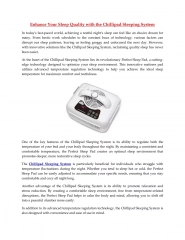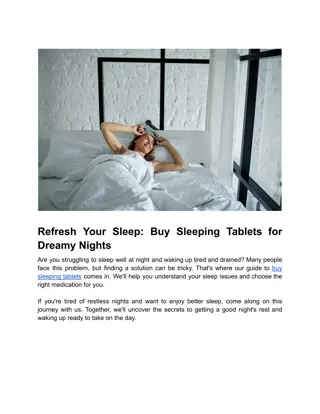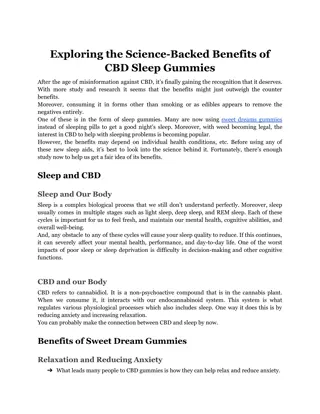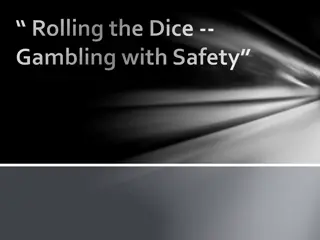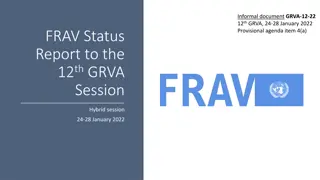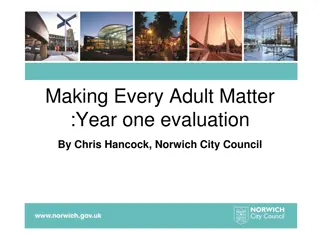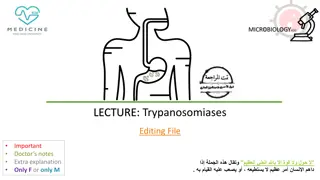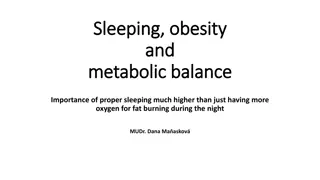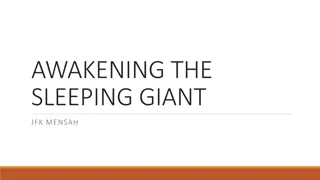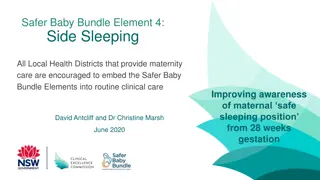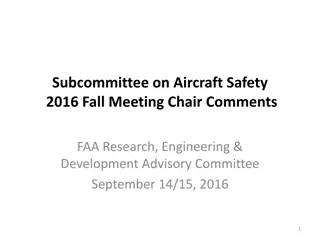Co-Sleeping: Understanding the Risks and Safety Recommendations
Sudden Infant Deaths (SIDs) can be prevented with safe sleeping practices. Co-sleeping, especially in hazardous situations, poses risks to infants. Recent data and recommendations for parents emphasize the importance of avoiding alcohol, drugs, smoking, and unsafe sleeping environments when sharing a bed with a baby. By following key safety messages, significant reductions in co-sleeping SIDS deaths can be achieved, ensuring a safer sleep environment for infants.
Download Presentation

Please find below an Image/Link to download the presentation.
The content on the website is provided AS IS for your information and personal use only. It may not be sold, licensed, or shared on other websites without obtaining consent from the author.If you encounter any issues during the download, it is possible that the publisher has removed the file from their server.
You are allowed to download the files provided on this website for personal or commercial use, subject to the condition that they are used lawfully. All files are the property of their respective owners.
The content on the website is provided AS IS for your information and personal use only. It may not be sold, licensed, or shared on other websites without obtaining consent from the author.
E N D
Presentation Transcript
Co Sleeping - 7 Minute Briefing
1. BACKGROUND Sudden infant deaths (SIDs) have been prevented by safe sleeping advice messages. Following the launch of the Back to Sleep Campaign in England and Wales in 1991 the number fell by 81%. In the UK in 2015 191 babies died suddenly (0.03% of all births) Previous data suggests that around die while sleeping in a Moses basket and around while co sleeping. It has been estimated that 90% of the co sleeping babies die in hazardous situations i.e a number of risk factors were present. Co sleeping includes parents or carers sleeping on a bed or sofa or chair with an infant
2. WHY IT MATTERS Within ABMU Health Board area since December 2016 there have been 5 sudden and unexpected deaths of babies in the community. All were sharing a bed with one or more parent at the time of death Current evidence/guidance suggests that with sensible, parent- centred communication, we could potentially reduce co-sleeping SIDS deaths by nearly 90% This briefing is to ensure that all front line workers with contact with families are aware of and are delivering the key safety messages about the risk factors which would make co sleeping hazardous.
3. INFORMATION All of the babies who died in ABMU were sharing a bed with one or both of their carers. All died at some time during the night and all were in their usual place of residence. None of the families had social work involvement at the time of death however 2 are now subject to child practice reviews. Further recommendations will be made when the reviews have been completed.
4. RECOMMENDATIONS FOR PARENTS The over-riding message to parents in relation to bed-sharing should be: Do not sleep with your baby when you have been drinking any alcohol or taking drugs (legal or illegal) that might make you sleepy Do not sleep with your baby if you or anyone else in the bed is a smoker Do not put yourself in the position where you could doze off with your baby on a sofa / armchair It is unsafe to sleep with your baby after immediate discharge from NICU or in early infancy if your baby was pre-term or of low birthweight. It is unsafe to let your baby sleep alone in an adult bed. If you are bed-sharing, make sure that your baby cannot: Fall out of bed or get stuck between the mattress and the wall. The advice on safe sleeping is the same for formula and breastfeeding babies and is place your baby on their back to sleep in a cot in a room with you for the first six months
5. RECOMMENDATIONS FOR STAFF Use the recommended leaflets when discussing risk and give to all new parents/carers when they have their baby home (to include when babies under 1 are placed with foster carers or extended family) listen carefully to parents/carers and offer information appropriate to their needs Following the adoption of the Healthy Child Wales programme Health Visitors are now required to ask to see where babies sleep which will provide opportunity for these discussions Safeguarding Recommendations: Safe sleeping should be routinely embedded within child protection plans and any other assessments or plans that are concerned with promoting an infant s welfare or well-being. If a parent/carer persists in placing their infant at risk against the advice of health care professionals than a referral to Children s Services should be made
6. SUMMARY OF CURRENT GUIDANCE/RESEARCH NICE guidance on routine post natal care, 2014 Sudden Unexpected Death in Infancy A Collaborative Thematic Review 2010-2012, Public Health Wales, 2015 Welsh Government Reduce the Risk of Cot Death , 2014 Lullaby Trust Safer Sleep for Babies: A guide for Parents , 2013 Unicef UK Co Sleeping and SIDS- A Guide for Health Professionals , 2017 www.isisonline.org.uk Parent Infant Sleep Lab
7. LEARNING OPPORTUNITY Are we compliant with NICE guidance? Are all staff aware of the risks associated with co sleeping? Do we routinely provide information to all new parents about the risks associated with co sleeping and if required do we check where the baby is sleeping? Do we routinely have these conversations with new parents? Do we routinely embed safe sleeping in child protection plans and assessments? Are we aware of how to access support for parents who do not have appropriate bedding see Baby Basics Bridgend and Swansea


